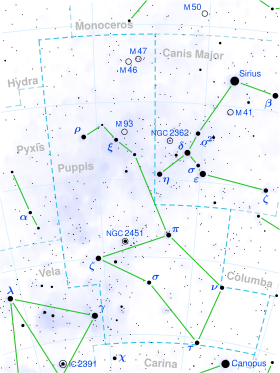20 Puppis
| Observation data Epoch J2000 Equinox J2000 | |
|---|---|
| Constellation | Puppis |
| Right ascension | 08h 13m 19.96710s[1] |
| Declination | −15° 47′ 17.6008″[1] |
| Apparent magnitude (V) | 4.99[2] |
| Characteristics | |
| Spectral type | G4 Ib-II[3] |
| U−B color index | +0.78[2] |
| B−V color index | +1.07[2] |
| Astrometry | |
| Radial velocity (Rv) | +16.80[4] km/s |
| Proper motion (μ) | RA: −12.718[1] mas/yr Dec.: −4.270[1] mas/yr |
| Parallax (π) | 3.2906 ± 0.1404 mas[1] |
| Distance | 990 ± 40 ly (300 ± 10 pc) |
| Absolute magnitude (MV) | −2.12[5] |
| Details | |
| Mass | 5.2±0.2[6] M☉ |
| Radius | 47.60+1.55 −1.16[1] R☉ |
| Luminosity | 1,087.12±53.98[1] L☉ |
| Surface gravity (log g) | 0.80[7] cgs |
| Temperature | 4,804+59 −77[1] K |
| Metallicity [Fe/H] | −0.18[5] dex |
| Rotational velocity (v sin i) | 6.9[8] km/s |
| Age | 90[6] Myr |
| Other designations | |
| Database references | |
| SIMBAD | data |
20 Puppis is a solitary[10] star in the southern constellation of Puppis. It is visible to the naked eye as a faint, yellow-hued star with an apparent visual magnitude of 4.99.[2] The star lies approximately 990 light years away from the Sun based on parallax. It is receding from the Earth with a heliocentric radial velocity of +16.8 km/s.[4]
This object has a stellar classification of G4 Ib-II,[3] matching a G-type star with a luminosity class part way between a bright giant and a supergiant star. It is just 90[6] million years old with around five[6] times the mass of the Sun. The star has expanded to 48[1] times the Sun's radius and is radiating 1,087[1] times as much luminosity as the Sun from its enlarged photosphere at an effective temperature of 4,804 K.[1]
References
- ^ a b c d e f g h i j k Brown, A. G. A.; et al. (Gaia collaboration) (August 2018). "Gaia Data Release 2: Summary of the contents and survey properties". Astronomy & Astrophysics. 616. A1. arXiv:1804.09365. Bibcode:2018A&A...616A...1G. doi:10.1051/0004-6361/201833051. Gaia DR2 record for this source at VizieR.
- ^ a b c d Ducati, J. R. (2002). "VizieR Online Data Catalog: Catalogue of Stellar Photometry in Johnson's 11-color system". CDS/ADC Collection of Electronic Catalogues. 2237. Bibcode:2002yCat.2237....0D.
- ^ a b Keenan, Philip C.; McNeil, Raymond C. (1989). "The Perkins catalog of revised MK types for the cooler stars". Astrophysical Journal Supplement Series. 71: 245. Bibcode:1989ApJS...71..245K. doi:10.1086/191373.
- ^ a b Gontcharov, G. A. (2006). "Pulkovo Compilation of Radial Velocities for 35 495 Hipparcos stars in a common system". Astronomy Letters. 32 (11): 759–771. arXiv:1606.08053. Bibcode:2006AstL...32..759G. doi:10.1134/S1063773706110065. S2CID 119231169.
- ^ a b Anderson, E.; Francis, Ch. (2012). "XHIP: An extended hipparcos compilation". Astronomy Letters. 38 (5): 331. arXiv:1108.4971. Bibcode:2012AstL...38..331A. doi:10.1134/S1063773712050015. S2CID 119257644. Vizier catalog entry
- ^ a b c d Lyubimkov, Leonid S.; et al. (2010). "Accurate fundamental parameters for A-, F- and G-type Supergiants in the solar neighbourhood". Monthly Notices of the Royal Astronomical Society. 402 (2): 1369. arXiv:0911.1335. Bibcode:2010MNRAS.402.1369L. doi:10.1111/j.1365-2966.2009.15979.x. S2CID 119096173.
- ^ Soubiran, Caroline; et al. (2016). "The PASTEL catalogue: 2016 version". Astronomy & Astrophysics. 591: A118. arXiv:1605.07384. Bibcode:2016A&A...591A.118S. doi:10.1051/0004-6361/201628497. S2CID 119258214.
- ^ De Medeiros, J. R.; Mayor, M. (1999). "A catalog of rotational and radial velocities for evolved stars". Astronomy and Astrophysics Supplement Series. 139 (3): 433. arXiv:astro-ph/0608248. Bibcode:1999A&AS..139..433D. doi:10.1051/aas:1999401. Vizier catalog entry
- ^ "20 Pup". SIMBAD. Centre de données astronomiques de Strasbourg. Retrieved 2019-06-04.
- ^ Eggleton, P. P.; Tokovinin, A. A. (2008). "A catalogue of multiplicity among bright stellar systems". Monthly Notices of the Royal Astronomical Society. 389 (2): 869. arXiv:0806.2878. Bibcode:2008MNRAS.389..869E. doi:10.1111/j.1365-2966.2008.13596.x. S2CID 14878976.

